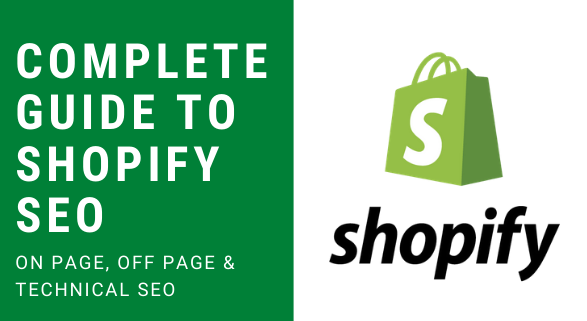SHOPIFY SEO
Once your Shopify e-commerce site is created, there is a very important step you need to go through: SEO.
To optimize the referencing of your Shopify store, and therefore ensure that your site arrives in the first search results on Google, you will need to follow certain best practices. These are not complicated and in this tutorial we will guide you step by step to guarantee you a good SEO optimization.
Here are the different ways Shopify puts at your disposal to improve the SEO of your e-commerce site:
- Title and Meta Description tags
- Alt tags
- The Apps
Title and Meta Description tags
The content of these two tags is directly visible in the search results, so it is very important to take care of it. You can configure the Title tag as well as the Meta Description tag on each page of your site.
Home page tags
For the home page, go to “Online Store” (under “Sales Channels”) then click on “Preferences”.
You can therefore enter the title of your site in the Title (70 characters maximum) and the description of your activity in the Meta Description (320 characters maximum).

Product sheet tags
You will also find these two tags on each of your Shopify product sheets.
To do this, go to “Products” then click on the name of your product to add the content to the Title and Meta Description tags.
In the “Search engine listing preview” section, you will notice that the name of your product automatically acts as a Title and that the description of your product corresponds to the Meta Description.
If you want to modify the content of the tags to add keywords for example, click on “Edit website SEO”.

In addition to being able to modify the tags, you will be able to modify the url of your page.
Warning ! If your product is already online it is strongly advised not to modify the url.

Tags from other pages on your Shopify site
Finally, the Title and Meta Description tags are present on each of the other pages of your site.
To modify their content, go to “Online Store” then click on “Pages”.
Then click on the page in question and as for your products, optimize natural referencing by including keywords in the tags.

Alt tags
Alt tags are linked to images in your Shopify store. It is simply alternative text if your image is not displayed correctly. It is advisable to fill in these Alt tags because their content is taken into account by Google for example to reference your site.
On the pre-registered pages of Shopify
Some pages are pre-designed by Shopify, here are the steps to fill in the Alt tags of the images.
Go to “Online Store” then to “Themes”. Click on “Customize”.

In the drop-down menu, select a page, for example the home page.

Go to a section with an image, then click on “Edit”.

You can then enter the content of the Alt tag. Don’t forget to click on “Save”.

On the other pages of your Shopify site
We are going to show you another way of filling in the content of Alt tags on the pages of your e-commerce site.
Go to “Online Store” then click on “Pages”. Then click on one of your pages.
Take the example of a Contact page. After creating this page, you may want to add an image. To do this, click on the image icon in the text box.

Select an image then you will see the field for the Alt tag appear.

On the product pages
Here the process is very simple. Go to “Products” then click on a product.
In the Images section, hover your mouse over an image to see the different options available to you, then click “Alt”.

To optimize the referencing of your Shopify product, it is advisable to add a short description of the image in question by including keywords. Click on “Done”.

The Apps
In Shopify, Apps are extensions that you can download (sometimes for free) to add functionality to your e-commerce site.
Shopify has many Apps for SEO optimization, but the best known is Plug in SEO .
Simply click “Get” to get the App.

Once the App is downloaded, you can find it at any time in the “Apps” menu from the administration of your Shopify site.
This App will simply analyze the different pages of your Shopify store and share with you points of improvement to optimize your SEO.
THE CONTENT OF THE WEB
Although it seems a truism, you should pay special attention to the content you insert on your website. Do not limit yourself to complete and that’s it. Take care of each of the words that you insert in your store. The customer will appreciate it and Google too.
Beware of duplicate content on other websites
A very common mistake in online stores is the high existence of duplicate content that other websites have.
Sure, you upload the catalog that the provider gives you. With all the information on their products but you have not realized that the rest of online stores have done the same. So when you look for the name of your product, Google has a lot of websites that have the same information. Exactly the same. Which one will it show? Probably the one that contributes something more.
I recommend that you personalize ALL the content of your website. From categories to products. Do not copy and paste from your provider
. If your website is already working, take it easy but be consistent. Do it little by little, every day 2 or 3 products. In less than you think your website will be wearing content that will be the envy of your competition.
Optimize your images and include videos
I was talking above about taking care of the content of your website. Pay attention to the text but don’t forget the images and videos. They improve the information and will give better service to your user.
Upload quality images and the name of the product they show. Don’t forget about the ‘title’ and ‘alt’ meta tags to give Google more information and to index them correctly. With the videos the same. Embed whenever you can product or explanatory videos .
They will improve the user experience, increase the time spent in the store and will surely generate more confidence for them to end up shopping. You can use YouTube to upload those videos and Google will like it even more. ????
Rich Snippets, Opinions and reviews
One last information that you should take into account on your website are the ‘rich snippets’. They are metadata that Google understands and that you can decide to use in search results. Surely you have seen on more than one occasion when searching for a product on Google, that some results have rating stars, or the price directly of the product. This information is collected by Google from your website if you have that metadata.
Discontinued or out of stock products: redirects
The eternal doubt. One of the common situations in online stores occurs with products that you can no longer sell, either because they are out of stock or because they are discontinued. what to do in that case?
First of all, don’t delete them. Keep in mind that this page is already indexed in Google and it will also have SEO weight. If you delete it, you will generate a 404 error when someone clicks on the indexed result in Google.
It is best to do a 301 redirect . If a similar product exists, then towards that product and if it does not exist, at least it sends the user to the product category. We could even leave the page as is and add a text that tells the user that this product is out of print but that a list of related products may interest you.
External links with head: Strategic Linkbuilding
Yes, external links still weigh heavily on SEO. I know there are people who say less and less. Today, I can assure you that quality backlinks represent 40% -50% of your ranking. Notice that I said about quality.
This is not about going out there and starting to put the url of your little store everywhere you can. That doesn’t count. Link building strategy is much more complicated than that. In fact, it is becoming more complicated and costs more because what Google searches for is natural. And if you go over the links, Google will notice.
So don’t do weird things, generate quality content, write on other websites, try to replicate the strongest links from your competition, etc.
An internet business website wouldn’t be finished without online networking! Web based life signals (developing your locale, connecting with clients, and sharing substance) sway your SEO.
Having a ton of social signs discloses to Google that individuals discover your site and brand significant.
You can start developing your social signals rapidly by adding social catches to your item pages, blog entries, and landing page.
As indicated by Jayson DeMers at Forbes, “A marked social nearness can assist work with wording of mouth that gets you clients, notices, and connections.”
Maybe the #1 online life channel you have to set up and connect on is Google+. Forbes says, “Google has been unequivocal that social signs assume a job in its calculation. Twitter and Facebook matter a few, yet a considerable lot of the query items from the two systems are confined.

